From a SEO expert who’s been doing this for a quarter of a century
I’m an expert at Search Engine Optimization (SEO). I’ve been doing it for 25 years and I’ve done it for some of the biggest companies in the world. So I speak from a bit of authority here.
I’ve also been a customer and fan of Amazon since 1998. You’ve probably noticed that there have been a lot of changes to their user interface over the years. Most people probably assume (as they do with Google) that all the changes were made for the benefit of their user experience. What you may not realize is that every change has really had one goal–to increase Amazon’s profits.
That’s not a bad thing–it’s Amazon’s job to increase its revenues and its stock price. But an unintended consequence is that some companies are very good at exploiting these changes as they happen, and others not so much so.

Take this example from the Toy department. 10 years ago, there was one company that made “a plastic toy with a white screen that you could draw on with a magnetic pencil. The brand was Magna Doodle. The Magna Doodle was invented by Pilot Corporation in 1974. Over the years they licensed the name to Tyco, Mattel, FIsher-Price, Ohio Art, Spin Master, and its current manufacturer, Cra-Z-Art. If you went to the Toys R Us, or KB Toys, or to your local hobby shop, they probably had a Magna Doodle.
But when you look at the Amazon product page, notice that the official version is lost in the jungle of imitators–it’s almost a joke how difficult it is to find, even on searches for its own brand name. Instead, you see strange brand names you never heard of like CHUCHIK, SGILE, NextX, Banne, Magnetic Drawing, SLHFPX, JOYIN, Misscat, HonShoop, Wellchild, Gamenote Extra, FLY2SKY, FONLLAM, Meland Magnetic, Hongkit, Boley, and dozens more.
And even stranger, you see these brands you never heard of with thousands upon thousands of 5-star reviews. They seem legitimate. And many of them are. But they didn’t necessarily start out that way.
Notice something else. All of the editorial placements, including the paid ads (on top), the “Amazon’s Choice”, the “highly rated” section, and the “Editorial recommendations” push the “fake brands”. Again, trying to find the original is literally like trying to find Waldo.
Remember that I said I’m an SEO expert, and my expertise isn’t just with ranking on Google but on Amazon as well. There are several things that will help a company get ranked on top of Amazon search results. These include the number of reviews, the frequency of reviews, how many products are sold, how well products are fulfilled, and how well the product copy is written.
I’ve also worked with lots of American and European companies, many in the Fortune 500, and many who specialize in consumer packaged goods. The vast majority of them are terrible at SEO. They hire an agency who doesn’t know anything about e-commerce SEO themselves. Those companies do the minimum to maintain their Amazon listings, but they foolishly believe that the rest is “automatic”. Just sit back and they’ll rank #1 in Amazon search results.
But what’s really happening behind the scenes?
First, if you haven’t read it yet, go back and read how companies in China form “joint partnerships” with Western companies and then over time realize that they can cut out the middleman, with full approval and support by the Chinese Communist Party.
I mentioned at the end of that article that the only missing piece is branding and distribution. And this is precisely how they’re solving that last piece of the puzzle.
Companies in China are manipulating Amazon’s system. Amazon doesn’t care, because regardless of who sells something on their site, they get the same revenue. In fact, they probably see much higher profit margins by enabling China-based companies because they don’t have to deal with the kind of overhead they have when working with Western companies.
Here’s their recipe to success.
- Create a decent quality product. It has to be a pretty well-made product, but that’s where these “joint ventures” have come in handy for companies in China.
Remember, Chinese partnerships and contractors were given the keys to the kingdom by Western companies who wanted them to produce their things for cheap. These Western companies breathlessly handed over expert knowledge, equipment, blueprints, industrial design, and other trade secrets. These China companies learned manufacturing techniques and processes. They learned how to source for the right raw materials. Heck, the West even paid the bills to build manufacturing facilities, infrastructure, and operations.
These Western companies just assumed that once their business relationships ended, the partners would honor their promises to just “forget” everything they learned and dismantle all the factories. After all, they signed a legal document, right? But remember if you’re a Western company who wants to sue a company in China for intellectual property infringement, who is the court going to be that adjudicates your case?
And so if you’re a company in China with a nice factory and all the trade secrets and skilled labor needed to build a product, what do you do? Of course, you start making your own stuff. If you’re smart, you’ll tweak things here and there in the product design to protect yourself from a lawsuit, but that can be done just by changing superficial things such as what the buttons look like or how the outer case is molded. For the core product, 100 years of industrial design secrets were handed over to you on a silver platter. - Make up a fake brand name. Hint: start with a consonant, follow it with one or two vowels, and add some more consonants. SELPOK. RIGANTO. HOOKLUK. Try it, it’s fun! Make this brand name on your product; print labels, register trademarks, do what you have to do to legitimize it. The beauty of a disposable brand name? If you get negative reviews or legal trouble, just throw out the brand name and come up with a new one.
- Submit your product to Amazon to be listed. Anyone can do it.
- Once approved, hire a copywriter to write product copy for you and a photographer to take photos (ideally with good looking white people in them) for you. You’re talking an expense of maybe a few hundred dollars. It doesn’t have to be the best, just a little bit better than your competitors. You don’t need a Web site or a PR department or anything. All you need to do is to work within Amazon’s site where your “brand” can look as legitimate as anyone else’s. And remember, big Western companies are lazy and don’t put a lot of time into it.
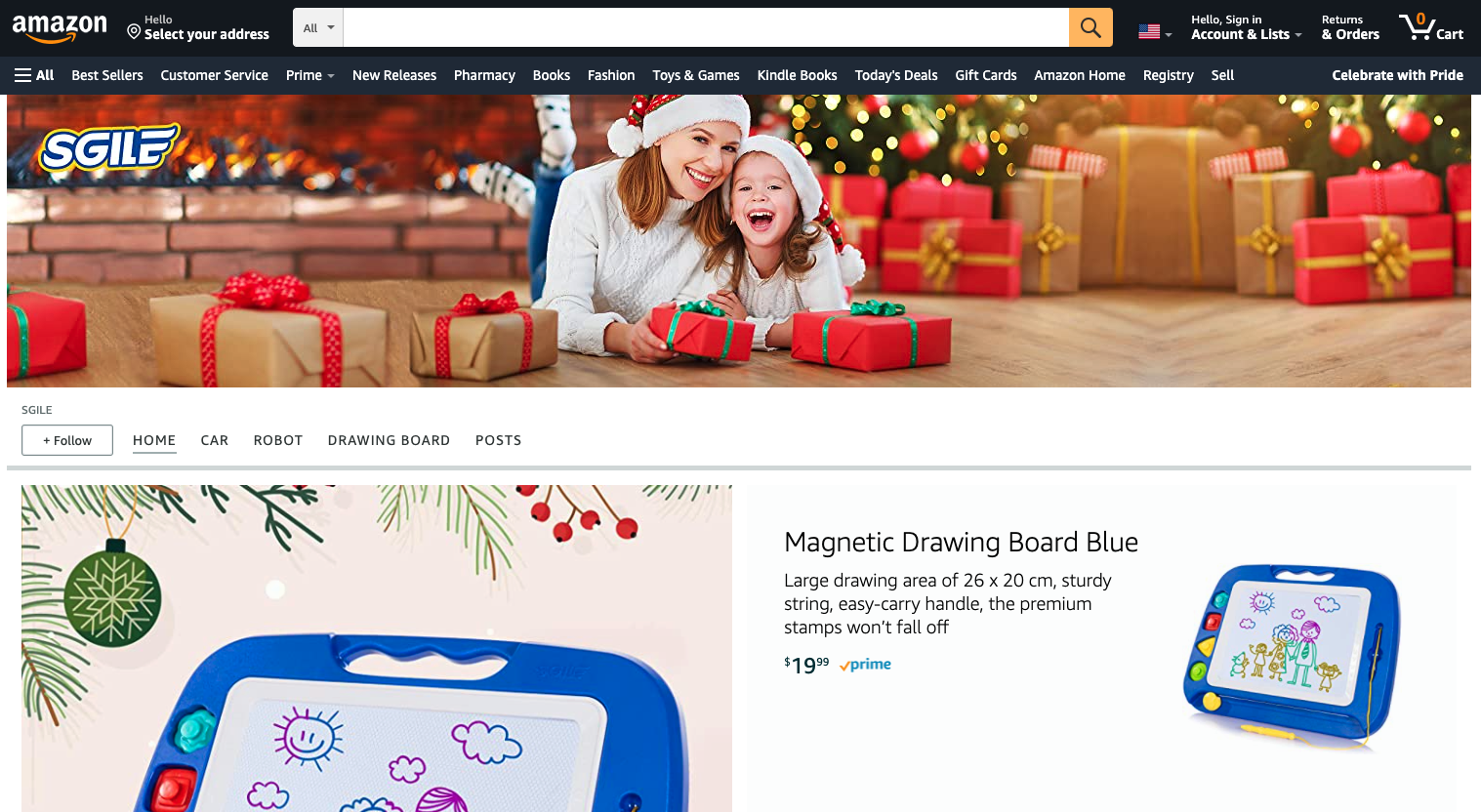
- Here’s the important part. Start selling your product, but make sure you have an army of people ready to “buy“ it and review it.
- Identify people who would sell their souls, their right arms, and their first-born children to get “free stuff”. There are tens of thousands of them. Offer to pay them for the cost of the product if they buy your product from their address and leave a review. Lo and behold you’ll start to see a lot of Amazon “verified purchases” that rave about the product.
- In 2016, Amazon officially put in their terms of service that “free stuff for reviews” services were against their terms of service (although interestingly they continued their Vine program that did the same thing). That only meant that this behavior went underground.
- Yes, the FTC in 2014 made a rule that any review that was incentivized in any way legally had to disclose that they were given something for their endorsement. But take a guess at how often the FTC enforces this rule? (or if it even can if the reviewer is outside of the United States).
- In 2016, Amazon officially put in their terms of service that “free stuff for reviews” services were against their terms of service (although interestingly they continued their Vine program that did the same thing). That only meant that this behavior went underground.
- Send your product for free to mommy bloggers and other “influencers”. If they like the product (which goes back to #1 above), they’ll publicize it to their followers.
- Put the product on sale for a short time and “Infiltrate” deal discussion boards and post links to the deal. That’ll get some further velocity going with views, reviews, and sales.
- Hire an army of reviewers through services like Fiverr (many of which themselves are run out of other countries). Pay hundreds or even thousands of people to write reviews. Many reviews will get flagged or removed by Amazon. But of course–many of them won’t.
- Just recently, Amazon penalized companies like RavPOWER and Aukey for incentivized reviews by removing them. Amazon happened to “catch” them because they got too big (and perhaps not coincidentally, removing them will conveniently increase sales for Amazon Basics products).
- But there are thousands upon thousands of other “fake” China brands across all of Amazon’s product categories that are too small and too scattered to get flagged. Will Amazon really be policing these? Here’s an example where Amazon rejects reviews that point out clearly faked reviews while allowing the faked reviews themselves to continue.
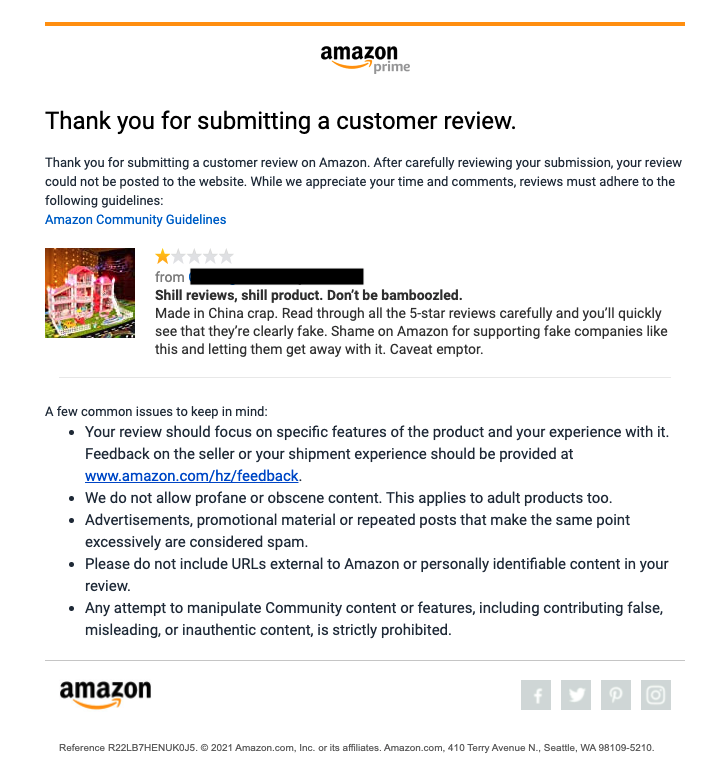
- Just recently, Amazon penalized companies like RavPOWER and Aukey for incentivized reviews by removing them. Amazon happened to “catch” them because they got too big (and perhaps not coincidentally, removing them will conveniently increase sales for Amazon Basics products).
- 1/5/22 update – The problem with Amazon censoring reviews is getting worse. This review was recently submitted to point out a product description that said “made in the USA” but the product was actually made in China. Not only is the seller NOT fixing its product copy, Amazon is rejecting any reviews that point it out. The consequence, of course, is that Amazon is aiding and abetting sellers who actively lie about country of origin.

- 3/5/22 update – I gave Amazon the benefit of the doubt with my first rejected review and even with my second review.
But with this third rejected review, it’s clear that there is a pattern here of Amazon instructing its reviewers to reject even honest, objective, and fair reports of incorrect country of origin.
In this particular case, the product listing said that a product was made in Vietnam. I bought it, but the box said “Made in China” when I received it. I submitted a review, and it was immediately rejected based on the incorrect claim that my review “had feedback on the seller” (even though the seller in this case was Amazon).
There is a chilling pattern here. One wonders how many thousands of other reviews are rejected in order for Amazon to continue to hide (or in this case blatantly lie) about products that are made in China?
- 1/5/22 update – The problem with Amazon censoring reviews is getting worse. This review was recently submitted to point out a product description that said “made in the USA” but the product was actually made in China. Not only is the seller NOT fixing its product copy, Amazon is rejecting any reviews that point it out. The consequence, of course, is that Amazon is aiding and abetting sellers who actively lie about country of origin.
- Identify people who would sell their souls, their right arms, and their first-born children to get “free stuff”. There are tens of thousands of them. Offer to pay them for the cost of the product if they buy your product from their address and leave a review. Lo and behold you’ll start to see a lot of Amazon “verified purchases” that rave about the product.
- When Amazon’s search algorithm sees a lot of activity (purchases, reviews, ratings, product page visits) around a product, it’ll lift those products in the rankings. Remember, the big brands assume all this stuff happens “naturally”, so while they’re sitting on their hands it’s these “throwaway brands” that put a lot of effort into manipulating the system and ultimately rise to the top.
- Here’s an important part. Get the same army of reviewers to find a negative review on the most popular product in your category and upvote it. Even the best products will have a negative review here and there. Vote up this negative review so that it appears on the top of the reviews when a potential buyer visits that page. In a lot of cases, that’ll cause them to abandon the product they’re looking for and “bounce” to your product (which helps get them further trending at the top of searches).
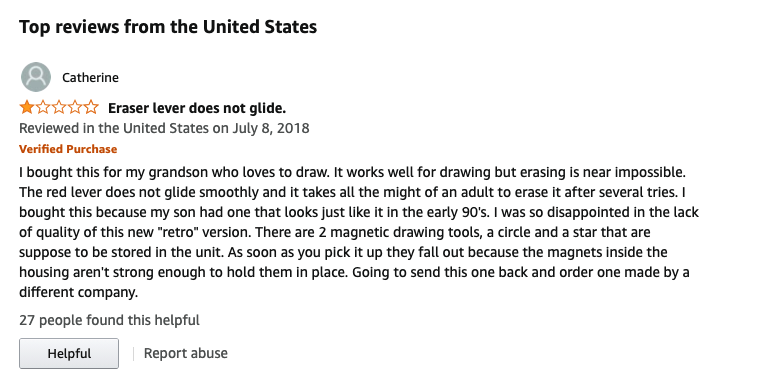
- At some point, “real” users will start to write reviews for your fake brand. Get that same army to upvote these “legitimate” reviews, burying the fake and manipulated ones. Assuming you followed rule #1 (create a semi-decent product), this should start a virtuous circle where “real” users start taking over.
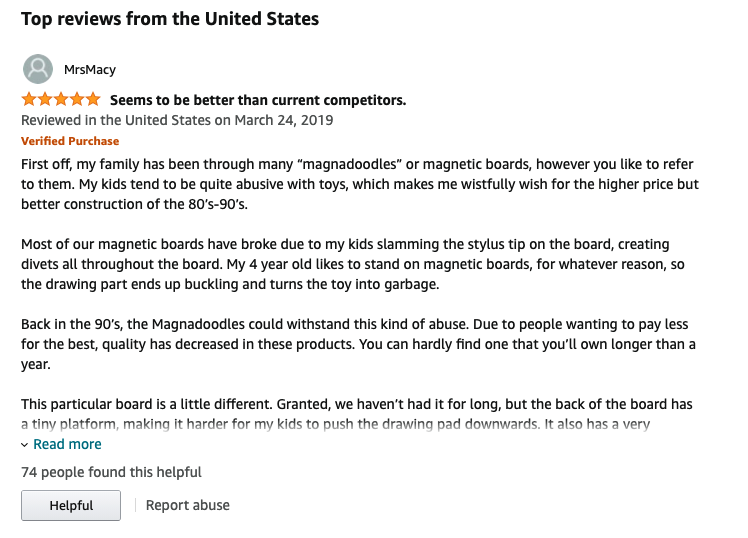
- Eventually, if your product attracts a bunch of views and visits it will get the attention of top Amazon reviewers who will want to weigh in. There’s really not a lot of benefit of rank-and-file Amazon reviewers, but don’t underestimate the power of the dopamine rush for many when they see their reviews get “likes” (just as on any other social platform).
- Have you noticed that Amazon is starting to feature “content” on its pages that highlight recommended products within the category? These look like objective reviewers, but they too get a commission for every sale, so they’re incentivized to just push the product they think is going to generate the most revenue for them–and many of them don’t even bother to even try the product, they’ll just cherry pick the ones with the top Amazon reviews.
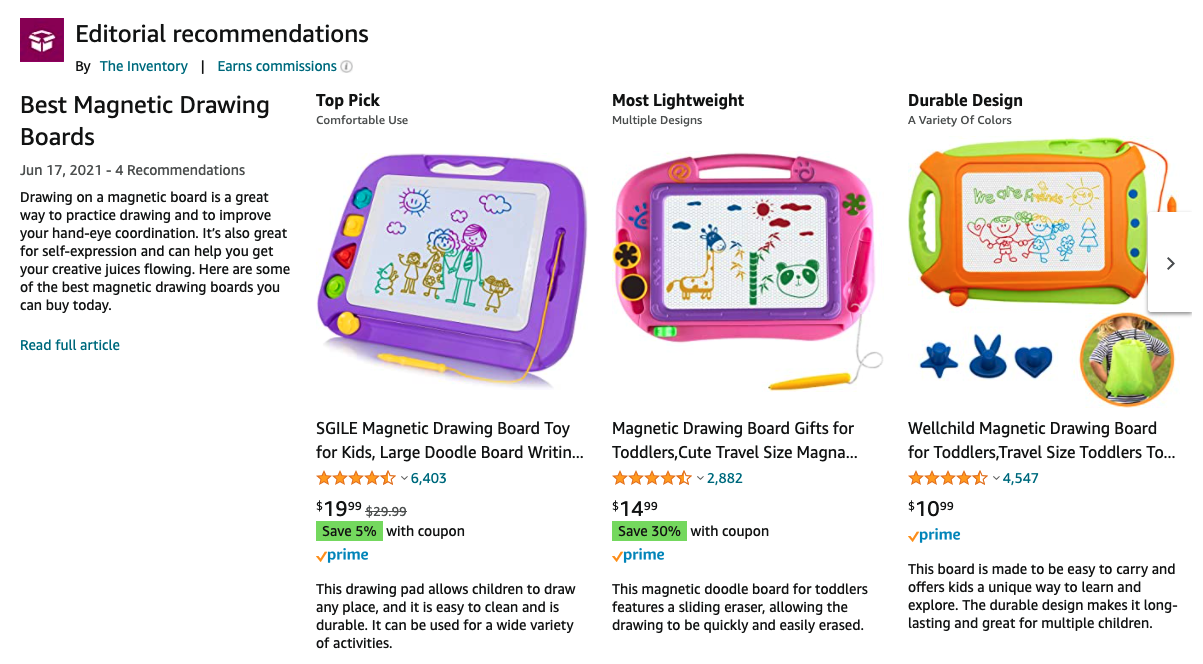
- Over time, these “fake” brands will start getting highlighted by and start getting picked up by “Top Amazon Reviewers”. I actually used to be a top 500 Amazon reviewer and trust me, it’s rarified air up there. Being a top Amazon Reviewer makes you a VERY popular person. Aside from the badges that Amazon gives you that make you feel special, you’ll suddenly start getting offered all kinds of perks, including manufacturers begging you to review their products and offering you whatever incentives they think they can get away with. And of course, the dopamine rush is addicting as you see the number of likes you have increase and to watch yourself rise on the leaderboard.
Here’s the kicker. In order to stay in the top 500 you always need to be publishing new reviews AND getting “upvotes” on your reviews. You need to start learning “tricks”. You need to learn how to identify products that will generate a huge number of reviews and upvotes. You need to strategically look at who’s above you and figure out how to get more upvotes than that person. It then becomes an arms race of who can provide more useful free content for Amazon.
As of course, as more “Top Amazon Reviewers” leave reviews, that boosts the Amazon algorithm to rank that product even higher.
- The holy grail is when “real” review sites like Wirecutter (or worse, “mommy bloggers”) start picking up your “fake” brand. They probably reviewed the product for real, but they would never have noticed the product if not for all the manipulation that was done to get the product on top in search. All these “consumer advocates” really care about is that affiliate commission they get if someone clicks through and buys a product. That’s 5% for them, 10% for Amazon, and 85% for the China company (at least 50% which goes directly into the coffers of the Chinese Communist Party through corporate and income taxes).
Also, notice that many, if not most, of the “fake” brands that show up on Wirecutter are praised for their low price. Again, this is thanks largely to the CCP, who you know is putting its fingers on the scales of the “free market”, flooding their products with the eventual goal of taking over entire industries with China-manufactured products.
I sort of picked on “Magna Doodle” listings because this was the first product I bought years ago where I was completely fooled into buying a fake brand from China. And remember, I’m an Internet professional with decades of experience in e-commerce. If I could be duped, I can only imagine how many millions of other shoppers can be as well.
To summarize, I don’t think Amazon is being nefarious here, but they are certainly being naive. In 1998 they built a system of product listings and reviews that works brilliants when all of the participants are acting in good faith.
Unfortunately, “good faith” is the last word I’d use to describe the Chinese Communist Party, who has weaponized information for the last 70 years. Since being granted Most Favored Nation status, they have encouraged the manufacturers under their control to take over entire sectors, even if it means stealing intellectual property. They keep costs low by cutting every corner possible and flaunting labor and environmental regulations.
They have no compunction against flooding Amazon with fake reviews–with the low costs and low barrier to entry, they can flood Amazon with hundreds of thousands of fake reviews, have thousands rejected, and still have a handful show up which will be enough to give it an edge in front of an unsuspecting public. They have no reservations against using the massive financial power of the state to give their products and companies unfair advantages in the marketplace–in fact, they see it as their moral obligation to do so.
If you’ve read this far, you’re probably asking, what can we do about it? The answer is, not a whole lot. All of the clichés about how to boil the ocean or how to eat an elephant come to mind. But you’re doing the first and most important step, which is getting yourself educated. The first thing you can do is to start supporting “real” brands again, not the “fake brands”. The better thing you can do is to look for “real brands” that do not use China manufacturing…that’s the only way that brands will get the message that there are things that are more important to the consumer than being the cheapest (in both price and quality).
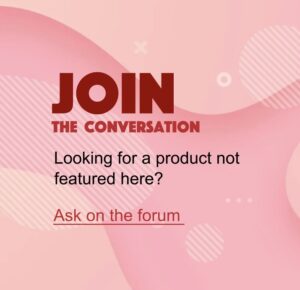
Thanks for providing this article to shed some light on the way that Amazon is manipulated by the CCP leadership.
I use a browser extension called “Cultivate” and it helps to reveal the brand/country of origin.
How does one tell on Amazon shopping which country has manufactured the goods?
Sorry for the late reply, but here’s a post I wrote with some tips.
https://notochina.org/how-to-tell-if-a-product-is-made-in-china-on-amazon/